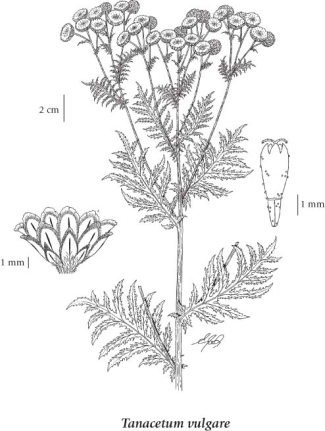common tansy
Asteraceae (Aster family)
Introduction to Vascular Plants
Species Information
General:
Perennial herb from a stout rhizome; stems erect, solitary, branched, glabrous to sparsely hairy, dotted with glands, 0.4-1.5 m tall.
Leaves:
Basal leaves lacking; stem leaves alternate, 10-20 cm long, 4-8 cm wide, unstalked or short-stalked, pinnately cut, the axis of the inflorescence evidently winged, the ultimate segments again pinnately cut or deeply lobed and toothed.
Flowers:
Heads disciform, numerous, terminal on the branches in a short, flat- to round-topped inflorescence; involucres 2-3 mm tall; involucral bracts lanceolate, in 2-3 series, keeled, firm except for the papery margin, hairy at the base; ray flowers lacking; marginal flowers glandular, 3-lobed; disk flowers yellow, 5-toothed into rounded lobes, sparsely glandular.
Fruits:
Achenes squared off at top, 1 mm long, 5-angled, glandular-dotted; pappus a minute, narrow-toothed crown.
Illustration

If more than one illustration is available for a species (e.g., separate illustrations were provided for two subspecies) then links to the separate images will be provided below. Note that individual subspecies or varietal illustrations are not always available.
Illustration Source: The Illustrated Flora of British Columbia
Ecology
The table below shows the species-specific information calculated from
original data (BEC database) provided by the BC Ministry of Forests and Range.
(Updated August, 2013)
| Site Information |
Value / Class |
||
|
Avg |
Min |
Max |
|
| Elevation
(metres) |
566 | 10 | 1900 |
| Slope
Gradient (%) |
5 | 0 | 42 |
|
Aspect (degrees) |
249 | 188 | 310 |
| Soil
Moisture Regime (SMR) [0 - very xeric; 4 - mesic; 8 - hydric] |
5 | 1 | 8 |
| Modal
Nutrient Regime
Class |
D | ||
| #
of field plots species was recorded in: |
13 | ||
| Modal
BEC Zone Class |
CWH | ||
|
All BEC Zones (# of stations/zone) species was recorded in |
BG(1), CWH(6), ESSF(1), IDF(3), SBS(1) | ||
|
Source:
Klinkenberg 2013
|
|||
Habitat and Range
Mesic to dry roadsides, fields, and disturbed areas in the lowland and montane zones; common in BC south of 55degreeN; introduced from Europe.Status Information
Synonyms
Synonyms and Alternate Names:
Chrysanthemum vulgare
Tanacetum boreale Fisch. ex DC.
Tanacetum vulgare var. crispum DC.
Taxonomic Keys
1. Heads disciform, numerous, usually 20-200.......................T. vulgare
1. Heads with ray and disk flowers, few to many, usually less than 20 2. Rays flowers white; leaves once or twice pinnately divided, the relatively broad segments often overlapping.......................T. parthenium 2. Rays flowers yellow; leaves twice to three times pinnately divided, the segments not at all overlapping........................T. bipinnatum Source: Illustrated Flora of British Columbia |
Taxonomic Notes
This species has become a common invader in southern British Columbia, often forming thick stands along roadsides and railway track verges. It is listed as one of the top fourteen species of concern by the Coastal Invasive Plant Committee, for more information visit their web site.
|